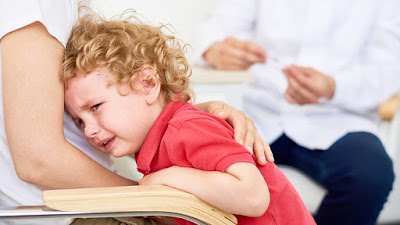Get to Know! Fear-Based on Child Age
"Why does that cat, Ma, keep following me! I got scared! "
Who's afraid of animals like cats, dogs, or cockroaches? Yes, fear can indeed approach anyone, especially children. Starting from fear of certain animals, certain objects, to fear of hearing loud sounds like the sound of explosive fireworks.
Well, did Parents know that the child's fear could be known through his age? For example, what are the things that children are usually afraid of when they are 5-6 years old? And, is the fear of children at 9-12 years old the same as when they were 5-6 years old?
Come on, we understand the various kinds of fears felt by children according to the following age!
Fear-Based on Child Age
0-6 Months
Babies can also feel scared. Usually, babies feel scared by the unexpected loud noise and surprise. Not only that, when the baby loses physical, hearing, or visual contact with an adult nearby, the baby also shows fear.
This is because the baby's brain that is responsible for permanent objects is not fully developed. When a baby loses contact with someone, the baby doesn't know that the person will come back for him.
7-12 Months
At this age, children have shown an understanding of permanent objects. Children understand that if they cry, someone will approach them. This condition causes the child to show fear when making contact with an unknown stranger because the child's brain has locked one person as to its main guardian. As a result, children begin to be shy towards strangers and still show fear of loud noises.
1 year old
Separation from parents is the biggest source of the fear of children at this age until continuing at the age of 6 years. At this age, children are still very dependent on adults and still feel scared by loud noises.
2 years old
Fear of animals and large objects often bothers 2-year-olds. They are also very afraid of the darkroom. Alarms fear children will increase there are changes in the environment around them.
3-4 years old
Entering the age of 3-4 years, the child's brain development is getting better so that the child's imagination also increases. This condition can make a child's dream look real and clear. For example, dreaming about monsters or other scary things. At this age, children can still be afraid of dark places, animals, and masks.
Aged 5-6 years
At this age children begin to fear physical injury and fear of "bad people". This can be seen in the habit of playing children who began to involve the characters "bad people" like the witch. The threat of lightning in the rain also still makes them afraid. Even so with the idea to sleep alone.
Ages 7-8 years
Entering the age of 7-8 years, children still feel afraid to separate from others. Including fear if shunned or left by friends. The child also begins to feel frightened about a car accident, or other physical pain. Fear in the darkness is also still felt by children aged 7-8 years.
9-12 years
The age of 9-12 years is a pre-teenage. At this age, the greatest fear of a child is more related to his achievement in school. Children begin to be afraid of various school exams. Children also begin to compare themselves with other children their age. The more children are oriented towards their peers, the more children feel fear or anxiety in themselves.
Teenagers
For teens, personal relationships can be a source of fear in him. At this age, children begin to feel afraid of world issues, for example, COVID-19 health issues that we are experiencing together. This condition is a sign of children becoming adults. Some children may also begin to be afraid of superstitions developing around.
How to deal with this fear?
1. Strengthening Stickiness
For children, the panacea of fear is to stay connected to adults who provide security and comfort. So, Parents need to increase attachment or closeness with children. Make sure we listen and are physically and mentally present to the child.
2. Playing with Fear
Playing with fear can also be used to face fear in children. By trying and making peace with these fears, it is hoped that over time the child will not be afraid anymore. For example, if the child is afraid to be alone in a dark place, invite children to play hide and seek to familiarize children with that place.
3. Crying
Helping children express fear by crying can also help children deal with their fears. For example, when children feel afraid of dark places, he can tell us while crying.


Post a Comment for "Get to Know! Fear-Based on Child Age"